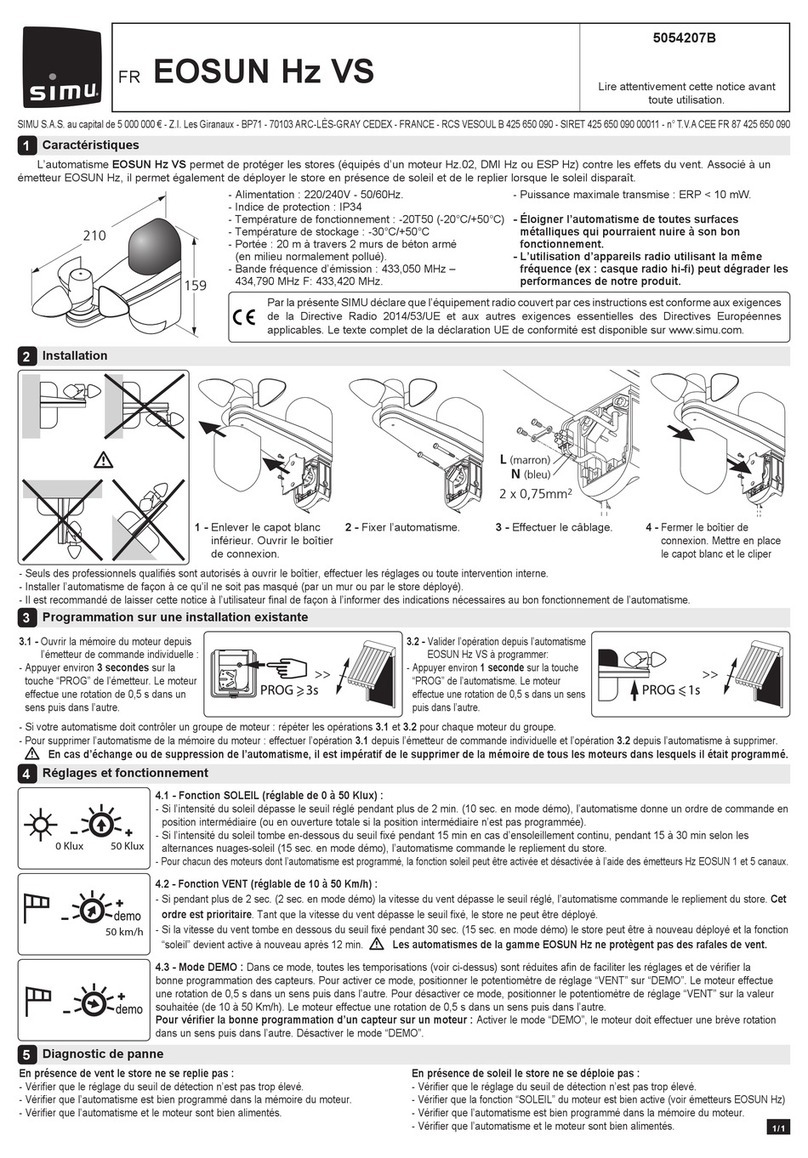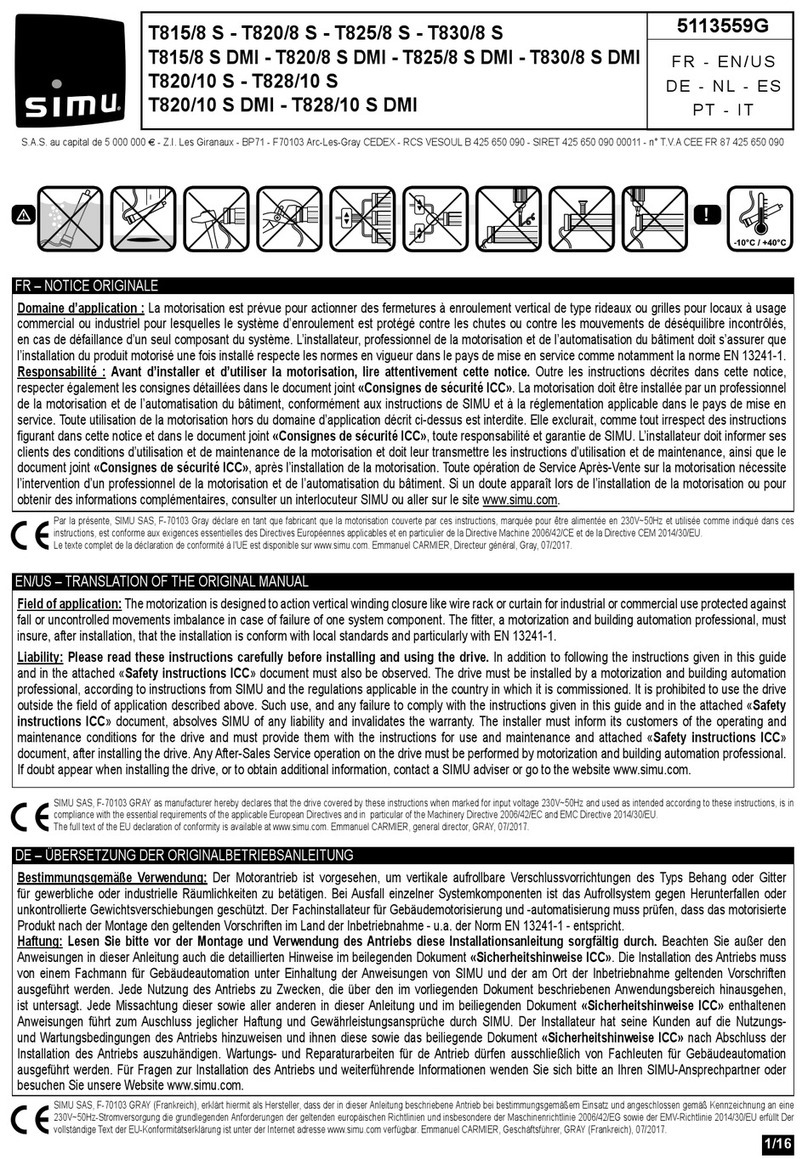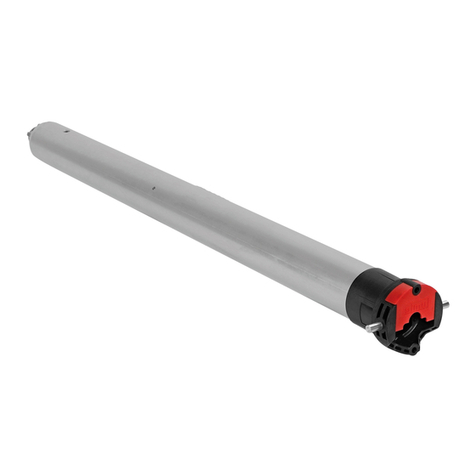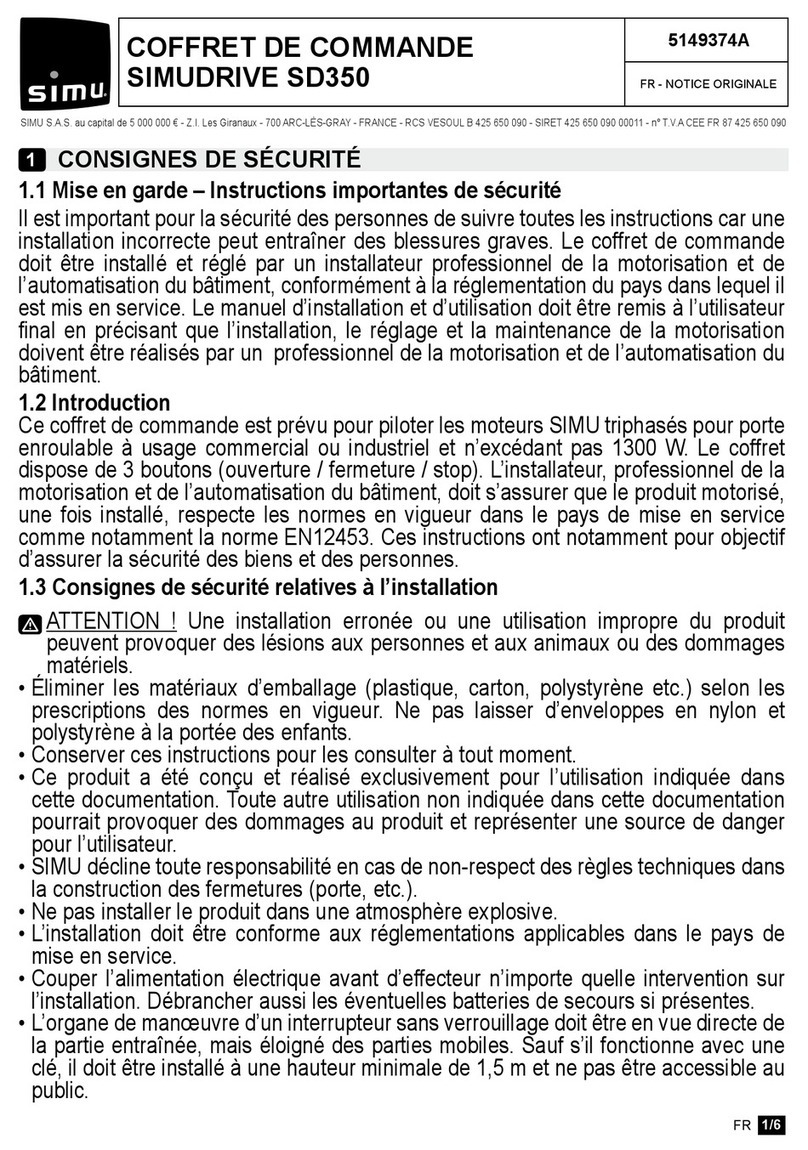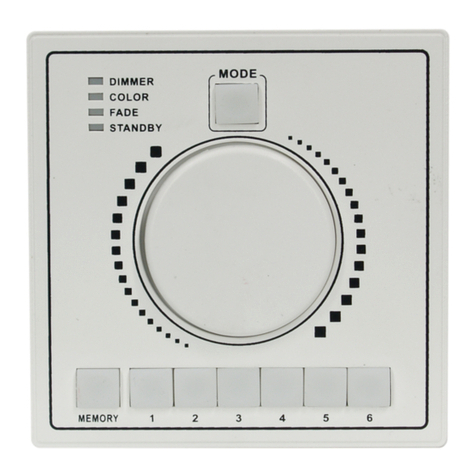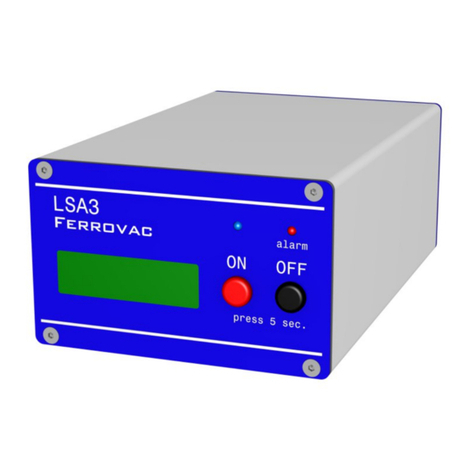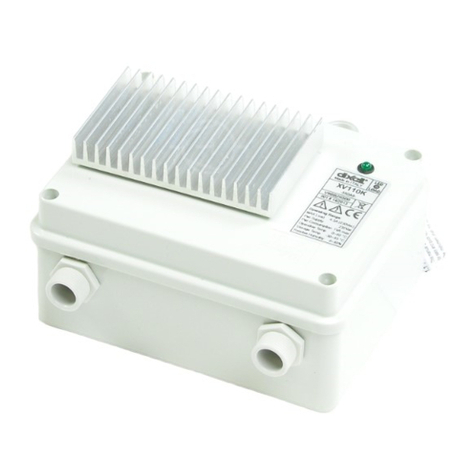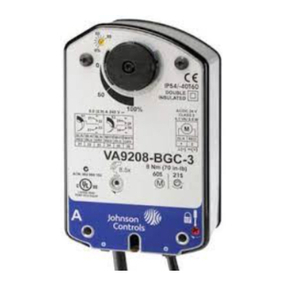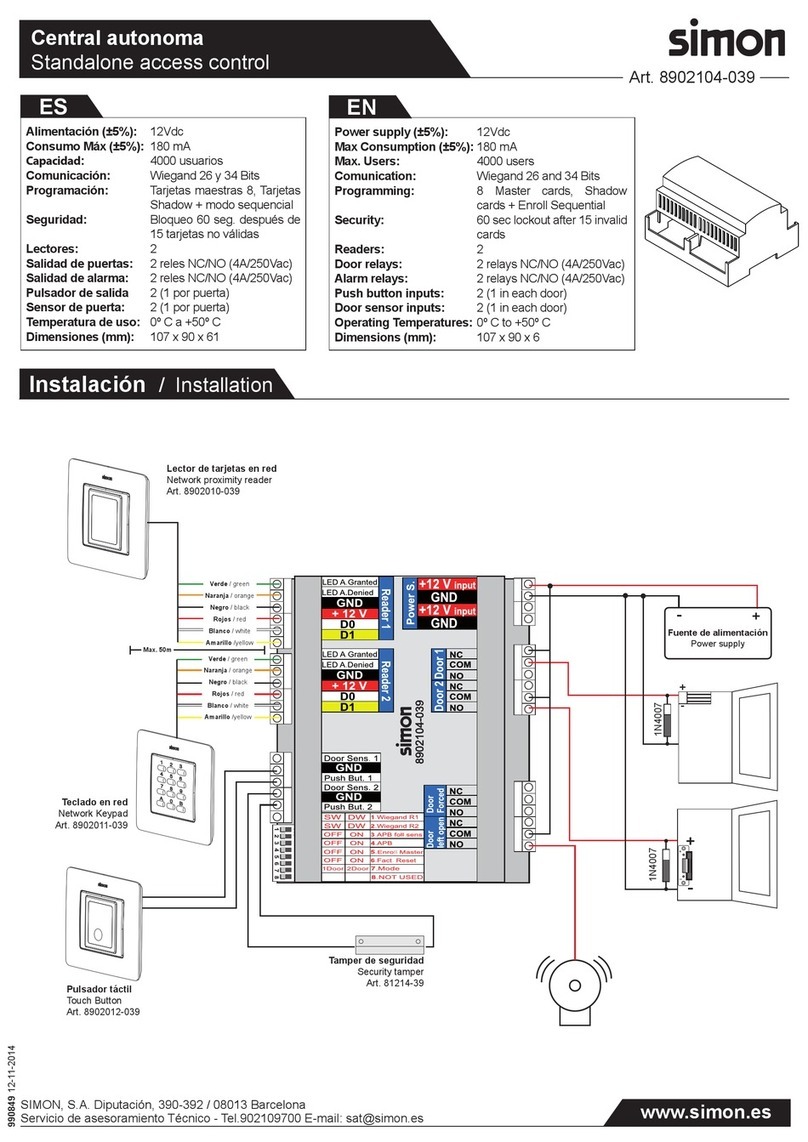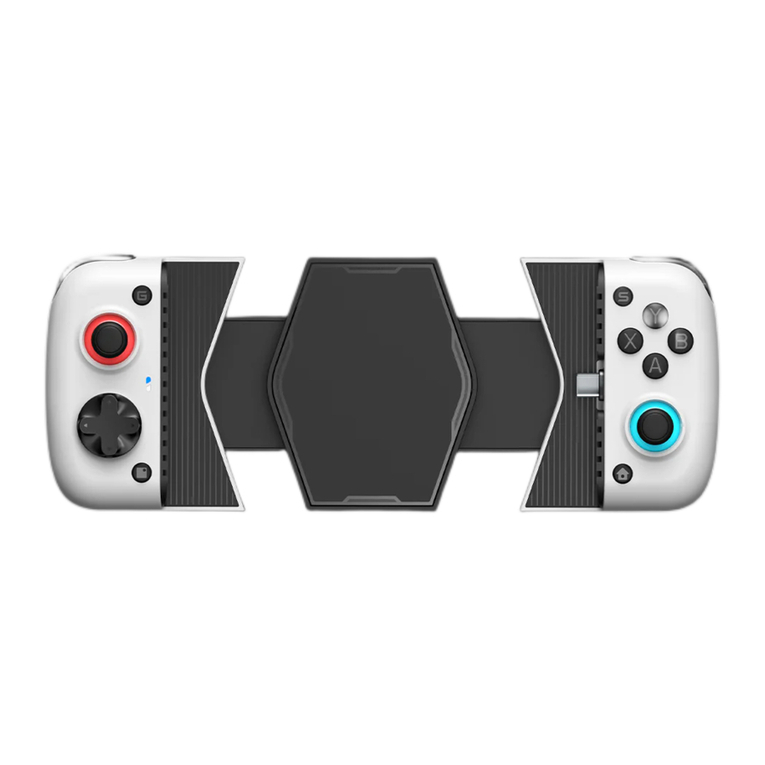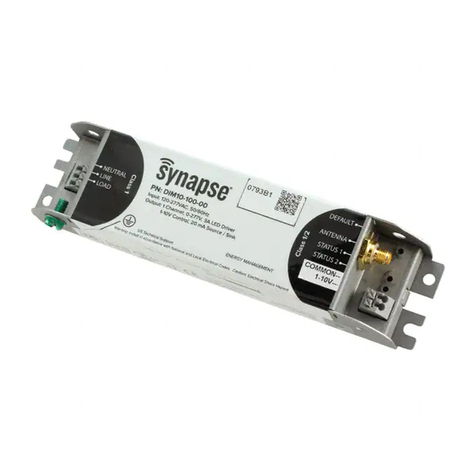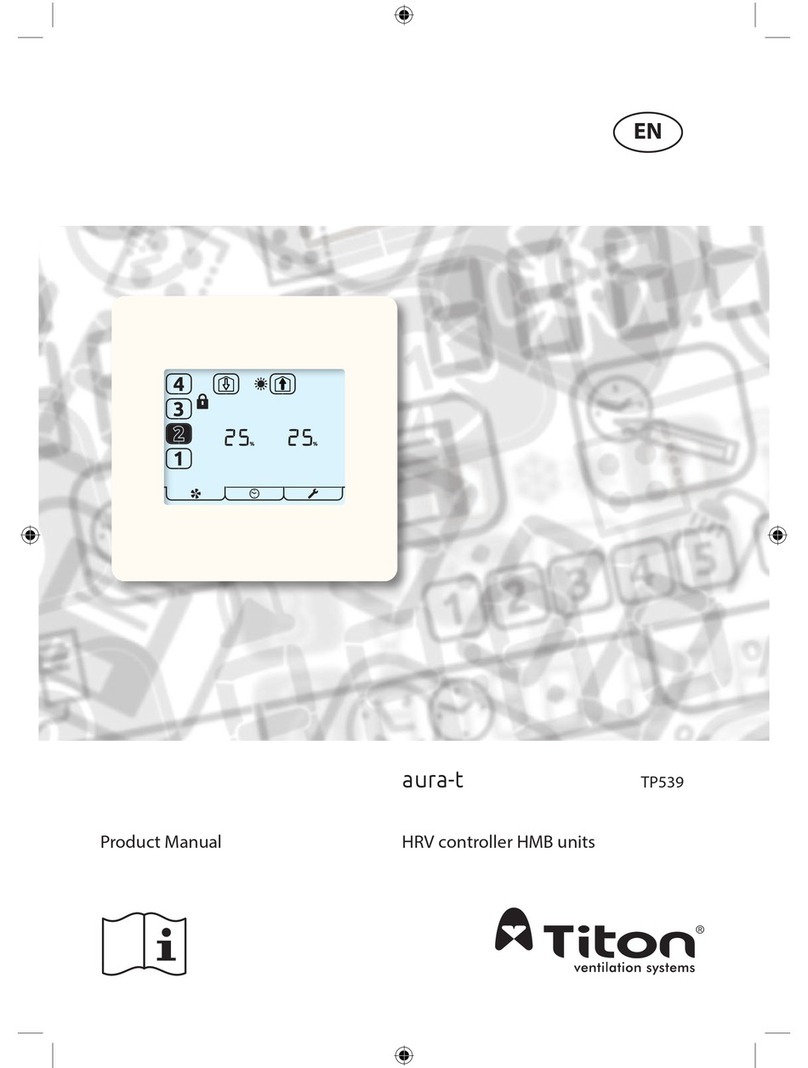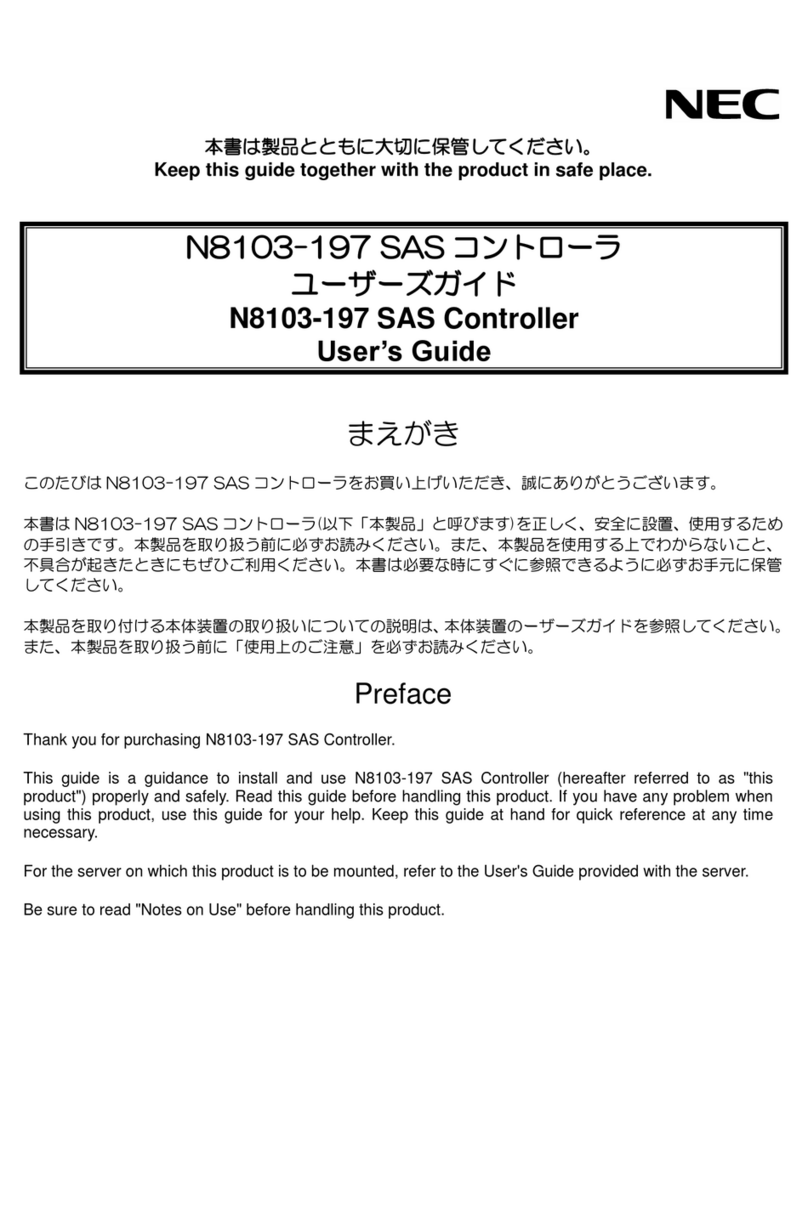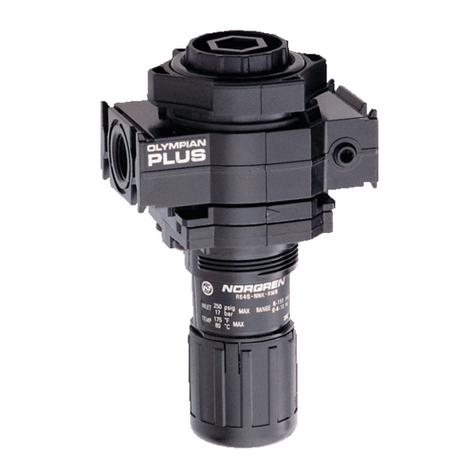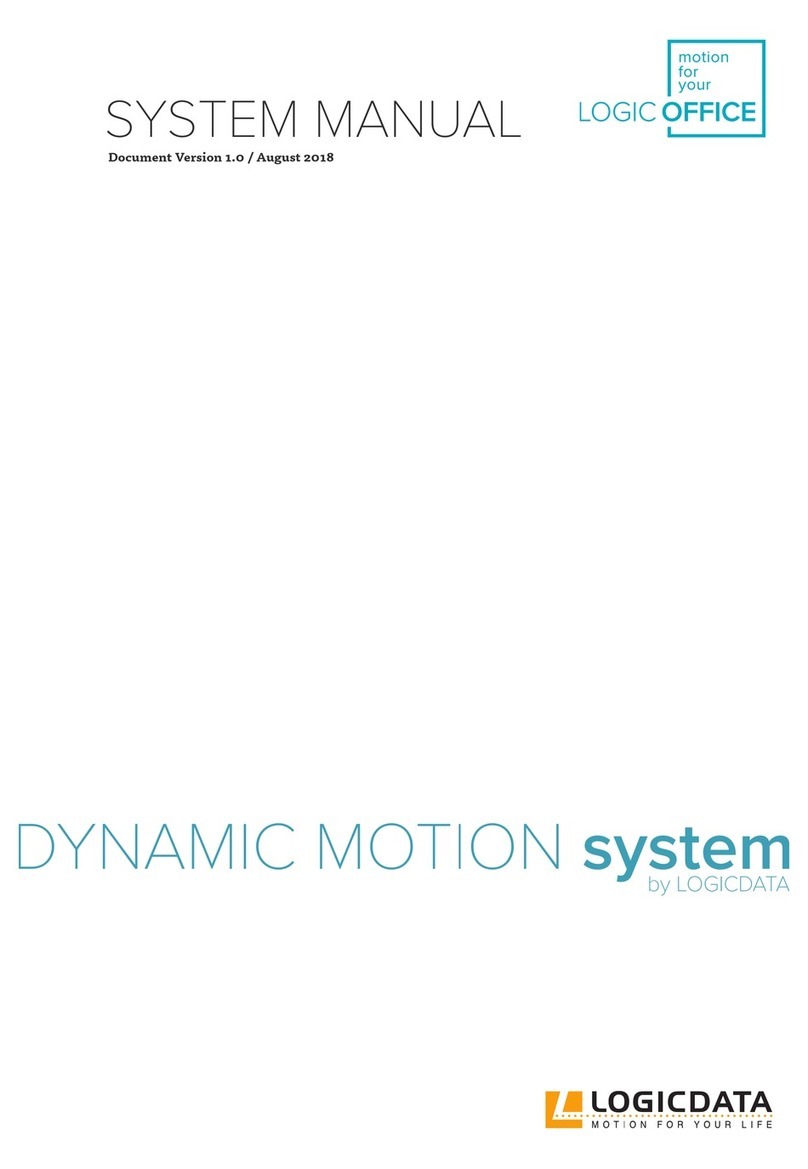Simu (X) 200 TRAN202 User manual

LIT DATE
RC200 S435 01-01-2001
MODEL SERIES
(X) 200
LINE
433MHz RADIO MOTOR CONTROL
Troubleshooting
- Check fuse
- Conrm that 120VAC is supplied to terminals 3 and 4
- Conrm that the receiver code has been memorized (see MEMORIZING
TRANSMITTER CODES WITH THE RECEIVER on reverse side of this page)
- Make sure you have generated a code for that button on the transmitter (see SETTING CODES IN
THE TRANSMITTERS on the reverse side of this page)
- Make sure the jumper is in terminals 8-9 if no safety device is used.
- If the jumper is in terminals 8-9 and the receiver still switches in just one direction, the transmitter
code may have been memorized as either an up or down signal. Delete the transmitter’s code
from the receiver memory (see ERRASING RECEIVER MEMORY on the reverse side of this page).
Then with dip switch 1 and 2 on, have the receiver memorize the transmitter’s code again (see
MEMORIZING TRANSMITTER CODES WITH THE RECEIVER on the reverse side of this page)
- Check limit settings on the motor.
- The timed run on the receiver is set too low. Increase the run time by
following the instructions in the paragraph“Run time programming (SW1) on page 2.
- Make sure the transmitter has generated a code for that button (see SETTING CODES IN
THE TRANSMITTER on the reverse side of this page)
- If the led LD is on continuosly, the receiver memory is full (has 24 codes memorized). Delete
some of the codes (see ERASING RECEIVER MEMORY on the reverse side of this page)
- Make sure the receiver is as far as possible from other receivers, metal objects, EMI
sources (oresent lights, transformers, computers, etc...) Try the receiver in dierent locations if
possible before hard wiring.
- If the receiver is mounted in a metal enclosure or in a remote location from where the
transmitters will be used with metal or other dense material in the line of sight, the receiver’s
antenna can be remotely located nearer to the area the transmitters will be used in (see
Installation on this page).
Problem: No response from the receiver
Solutions if led PW is o
Soultions if led PW is on
Problem: Receiver only switches in one direction
Solutions
Problem: Motor stops/receiver turns o before the motor reaches the limit.
Solution
Problem: The receiver will not memorize a code from a button on the transmitter
Solutions
Problem: Range is poor
Solutions
TRAN202
TRAN204
TRAN212
TRANWS200
RC200
SIMU U.S Inc.,
6100 Broken Sound Parkway N.W., #14
Boca Raton, FL 33487
Phone: 561-995-0335 FAX: 561-995-7502
Description
Use
Transmitters
Receivers
Installation
Electrical connections
-
Terminals
TECHNICAL SPECIFICATIONS
Receiver
Transmitter
The (X) 200 radio control system consists of one or more transmitters and one or more receivers
which can be combined to meet the specic needs of a wide variety of systems.
The (X) 200 control has a highly reliable and system that uses an algorithm to
recognize only specic variations of the original transmitted code. The receiver is able to memorize
This allows a receiver to be activated by multiple
transmitters.
The (x) 200 radio control can be used with Type 3.5, Type 5 and Type 6 120VAC SIMU motors. One
RC200 is required for each motor unless used with SIMU group control relays (RI2, RI3, and GI2).
Each RC200 receiver can be controlled individually from 1 channel (1 button on a transmitter)
when the code is programmed into the RC200 in sequencing mode (open-stop-close-stop..). using
dip switch SW1(on/on). Groups of RC200 receivers can be controlled together by programming
one button as an open for all receivers in a group using dip switch SW1 (on/o ) and one button on
the transmitter as close using dip switch SW1 (o/on).
TRAN202 Two channel transmitter 2 Buttons
TRAN204 Four channel transmitter 4 Buttons
TRAN212 Twelve channel transmitter 4 Buttons and A-B-C slide switch
TRANWS200 Four channel wall-switch transmitter 4 Buttons
RC200 Motor control receiver in surface external box
RC210 Motor control receiver recessable in plastic 3 gang switch box (interior only)
RC201 12/24VDC 2 channel dry contact output receiver
Disconnect power before installing.
- High voltage 120VAC wires must pass through the holes marked “A”(see g. 9)
- Low voltage wires must pass through the holes marked “B” (see g. 9) and must be routed
separately from the high voltage wires.
secure rolling code
24 dierent codes in its non volatile memory.
IMPORTANT : For installation by a qualied electrician in accordance with local
electrical codes.
- CAUTION: RISK OF ELECTRICAL SHOCK.
The receiver bracket should be mounted to the wall with the included screws. The receiver can then
be slid onto the bracket. If mounted in an exposed location, the receiver must be mounted with
holes marked A and B (see g. 9) facing down. Receivers should not be mounted within 5 feet of
each other. Do not mount the receiver in a metal box, near metal, or near EMI sources. It is
recommended that the range of the unit be tested before permanently wiring the receiver. If range is
poor, often relocating the receiver by a few feet can drastically improve the reception. If the
receiver must be installed in a metal box or located in a remote location, the antenna can be
remotely located. Connect the shield of a coaxial cable to terminal 12 and the center conductor
to terminal 13. Run the cable to a clear location near where the transmitter will be used and strip
the shielding o the last 17cm (exact length of antenna supplied with unit)
!
1-2 Ground (Motor Green)
3 Hot 120 VAC 60HZ
4 Neutral
5 Motor direction 1 (Motor Black)
6 Motor direction 2 (Motor Red)
7 Motor common (Motor White)
8-9 N.C. low voltage input for safety device. Jumper must be installed if safety device not used
10-11 N.O. low voltage input with sequencing function (open-stop-close-stop-open...) for single
throw, single pole low voltage switch (Ref# SPBS.W)
12 Antenna ground
13 Antenna connection for 17cm wire supplied with receiver. The antenna can be remotely
located using 50 Ohm coaxial cable as described above in“Installation”
- Reception frequency........................................................................................................433.92MHz
- Local emission..........................................................................................................................<2nW
- Antenna input impedance..................................................................................................50 Ohms
- Sensitivity.......................................................................................................................................1uV
- Power supply............................................................................................................120VAC 50-60Hz
- Operating temperature range.....................................................................................-20 C...+60 C
- Carrier frequency.............................................................................................................433.92MHz
- Carrier frequency tolerance.................................................................................................+75MHz
- Band width............................................................................................................................>25kHz
- Power supply (alkaline battery GP23A)......................................................................12V+10%
- Maximum power consumption..................................................................................................25mA
- Operating temperature range....................................................................................-10 C...+55 C
NOTE: This equipment LH8TX-S435 and LH8RP-S435 has been tested and found to comply with limits for a
These limits are designed to provide reasonable protection
against harmful interference to radio communications.
However, there is no guarantee that interference will not occur in a particular installation. If this
equipment does cause harmful interference to radio or television reception, which can be
determined by turning the equipment o and on, the user is advised to try and correct the
situation by taking one or more of the following measures:
D Reorientate the receiving device
A Increase the distance between the equipment and the receiver
S Connect the equipment to a socket which is on a dierent branch circuit than the receiver
S Consult your dealer or an experienced radio/TV technician for help
ZVL408.01-P1 Mod: 18-04-2008
class B digital device, according to part 15 of FCC rules.

*8&9: N. C. Reversing Sensor
10&11: Remote Override Switch (SPBS)
12: Coax Antenna Connection (not supplied)
13: Standard Antenna (supplied with unit)
* NOTE: If you are not using a safety device a
jumper wire must be connected to
terminals 8 & 9.
Do not cut antenna wire supplied with this unit.
RC200 Receiver
PW
POWER IN 120VAC
HOT
NEUTRAL
GROUND
Antenna
*JUMPER
MN.O. SINGLE POLE
SINGLE THROW SWITCH
(REF#SPBS)
GREEN
RED
WHITE
BLACK
LD
1 2
CODE
MEMORY
8910 11
12 13
1
234 5 67
SW1 P1 P2
MEMO DELETE
ON
A
B
C
EXTERNAL DIMENSIONS
BATTERY REPLACEMENT
SETTING THE TRANSMITTER CODE
WIRING DIAGRAM (fig. 9)
A: Entry holes for 120VAC
B: Entry holes for low voltage wiring and antenna
D: Hole plugs
PW: Power light
SW : Function selection switch
P1: Memorize button
LD: Signal LED
P2: Delete button
1: Ground (Green)
2: Ground (Green)
3: Hot 120VAC
4: Neutral
5: Direction 1 ( Black )
6: Direction 2 (Red)
7: Common (White)
1
2
N
O
1
2
N
O
1
2
N
O
1
2
N
O
PROGRAMMING
SETTING CODES IN THE TRANSMITTERS (Fig. 1-6)
MEMORIZING TRANSMITTER CODES WITH THE RECEIVER
1) Open the access door (Fig. 1)
2) (Only on 12 channel transmitter) Select block of channels
with ABC slide switch Y1 (Fig.2)
Y1 in position A = channels 1-4
Y1 in position B = channels 5-8
Y1 in position C = channels 9-12
3) Press button J1 (Fig3)
4) While holding down button J1, press one of the transmitter
buttons CH and the light L1 will start flashing (Fig 4.)
5) Release the transmitter button CH and the light L1 will
continue flashing (Fig5)
6) Release the button J1 and the light will go out (Fig 6) That
transmitter button CH now has its code programmed.
7) Repeat steps 3-4-5-6 for each of the buttons CH on the
transmitter.
8) If using a 12 channel transmitter (4 buttons CH and ABC
slide switch Y1), repeat steps 2-3-4-5-6-7 with the slide
switch Y1 in each position. (A-B-C)
IMPORTANT: It is recommended for the receiver memory
to be cleared before memorizing transmitter codes for
the first time. Press buttons P1 and P2 simultaneously for
5 seconds until led LD flashes rapidly.
Dipswitch SW1 functions (Fig. 9)
DIP1 ON / DIP2 ON
Memorized code control in sequencing function.
OPEN-STOP-CLOSE-STOP-OPEN.....
DIP1 OFF / DIP2 OFF
Run time programming
DIP1 ON / DIP2 OFF
Memorized code will give up command
DIP1 OFF / DIP2 ON
Memorized code will give down command
1) Using SW1 select the function to be associated with that
button on the transmitter. (ON/ON) Is standard for individual
control.
2) Press button P1 and the LED labeled LD will start to flash
3) While holding down button P1, bring the transmitter within 6
inches of the receiver and press the transmitter button CH
you wish the receiver to memorize. The LED LD will flash faster
4) Release the transmitter button CH and the receiver button
P1. The receiver has memorized the code for that button on
the transmitter.
5) Repeat steps 1-2-3-4 for all other transmitter buttons you
wish the receiver to memorize.
6) When finished programming the receiver move both
dipswitches on SW1 to the off position.
* If the receiver will not memorize a code it could be due to:
- The memory is full (24 codes memorized) and led LD
remains lit. If this is the case, a new code can be
memorized only after one is erased or the whole memory
is cleared. (See “ERASING RECEIVER MEMORY BELOW)
- The code is already in memory
- You have not generated a code for that transmitter button.
(See “SETTING CODES IN TRANSMITTERS” ABOVE)
To erase a single transmitter button code from receiver memory
1) Press and hold button P2 and the led LD will flash slowly
2) Press the button of the receiver you wish to erase and hold
for 3 seconds until led LD flashes faster. The code is erased.
3) Repeat steps 1 and 2 for each button on all receivers you
want to erase from the receiver’s memory.
To erase the entire memory of a receiver
1) press and hold buttons P1 and P2 for at least 5 seconds
until led LD flashes rapidly. The whole memory is cleared.
ERASING RECEIVER MEMORY
CH1
CH3
CH2
CH4
Run time programming (SW1)
- move the door/shutter to the completely closed position;
- press and hold down the MEMO button for 4 seconds:
release the button when the LED starts to flash;
- press the MEMO button once, within 10 s, to start the
opening manoeuvre; when the door/shutter has stopped in the
completely open position, wait for 2-3 seconds and then press
the button again to memorise the run time; this completes
the program function and the LED will switch off;
NOTE: during programming the photoelectric cells are ignored
and the LED will flash rapidly indicating that the run time is being
counted.
• The maximum programmable run time is 120 seconds.
F1 - 4.0 A
ZVL408.01-P2 Mod: 18-04-2008


PAGE: 2 of 2
AA
BB
CCDD
EEFF
CDR 863 with SMCCDR 863 with SMC
”1.5”1.5
.5 ”
3 4
.5 ”
3 4
1.96”
1.96”
1
3
2
A: Mounting Gasket
B: Base Plate
C: Cover Gasket
D: Adjustable Optic
E: Control Board
F: Cover with Optic Window
ASSEMBLY
Test Point
+
_
112233445566
24V
+
12V
+
0V
- NC NO COM
~ ~ ~
Receiver
11223344
24V
+
12V
+
0V
-
~ ~ ~0V
-
~
Emitter
112233445566
24V +
12V +
0V -
NC
NO
COM
~
~
~
C
NC
NO
C
NO
NC
180
+30
-30
Fig. 1
Fig. 2 Fig. 3 Fig. 4 Fig. 5
DIMENSIONS CONNECTIONS TEST POINT ALIGNMENT
Description
The CDR863 is an outdoor/indoor photoelectric beam and can be used with
the SMC to control a tubular motor covering passage way up to 30’ outdoors
and 45’ indoors.
Mounting (Fig. 1)
1) Using the template on the lid of the box, mark the position of the transmitter
and receiver and install gasket (A) and the mounting plate (B) in the desired
locations using the four #6 flat head wood screws. When mounting to other
than wood surfaces use the appropriate anchors.
2) Run the wires through the hole in the gasket and mounting plate and into
the unit.
Wiring and Calibration
WARNING: DO NOT APPLY POWER UNTIL ALL CONNECTIONS HAVE BEEN MADE!
1) Connect wires as shown on page one of this addendum.
2) Power the units. The red LED on the transmitter will light. The red LED on the
receiver will light only if the optic eyes are not aligned
3) Align the eyes using a DC voltage meter on the test point (Fig. 4). The meter
should read 0.9V or higher when aligned.
4) Seal the wire holes using the supplied rubber plugs. Install the cover and
secure with supplied screws (Fig. 1 a,b,c)
5) Test the function. Note: If the eye causes the door to lower instead of raise,
reverse the red and black motor leads.
Technical Specifications
Optical
Range: (outdoors) up to 30 ft.
(indoors) up to 45 ft.
Transmitter beam width: 6 degrees (typical)
Receiver field of view: 6 degrees (typical)
Adjustment Vertical: +/- 30 degrees
Horizontal: 180 degrees
Electrical
Voltage: 12 or 24 VAC/VDC _ 10%
Current consumption @ 12V: 23mA (rest) 65mA (active)
Current consumption @ 24V: 29mA (rest) 68mA (active)
Relay: Form C (Com, NO, NC)
Relay drop out with loss of power
Contacts rated 60VA @ 24VDC/VAC
Max 30VDC/VDC
Infrared source: Double Gallium Arsenide LEDs
Transmitter frequency: 4.7 kHz
IR wavelength: 950 nm
Environmental
Operating temperature: 14 to 131 degrees F (-10 to +55 degrees C)
+
APPENDIX 2
This manual suits for next models
6
Other Simu Controllers manuals
Popular Controllers manuals by other brands
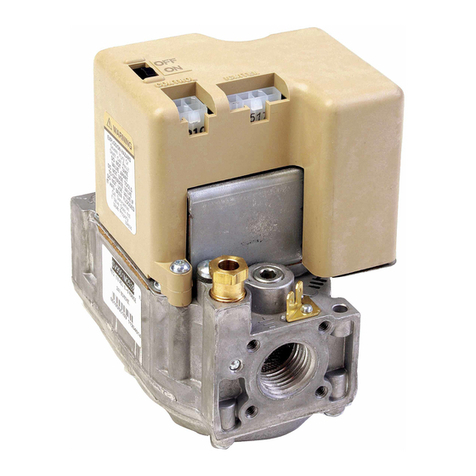
Honeywell
Honeywell TRADELINE SV9501 installation guide
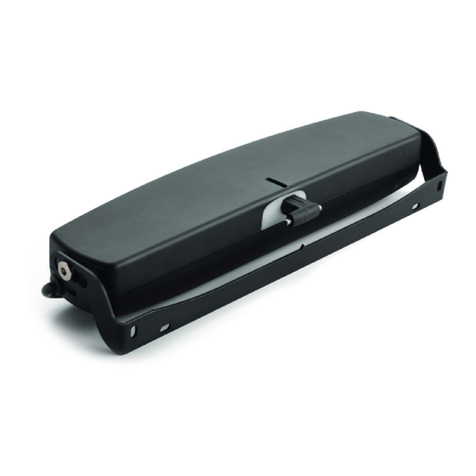
Vimar
Vimar ELVOX EG30/N instruction manual
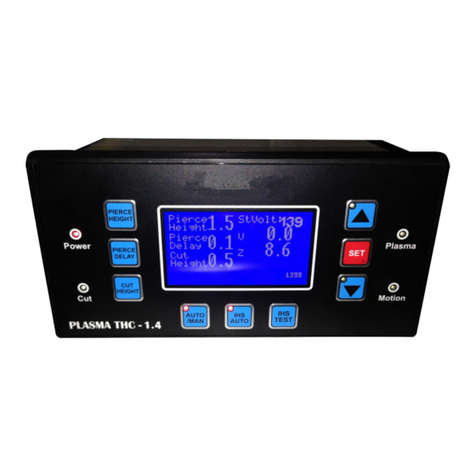
NT Engineers
NT Engineers DigiCut PLASMA THC 1.4 Installation & operation manual
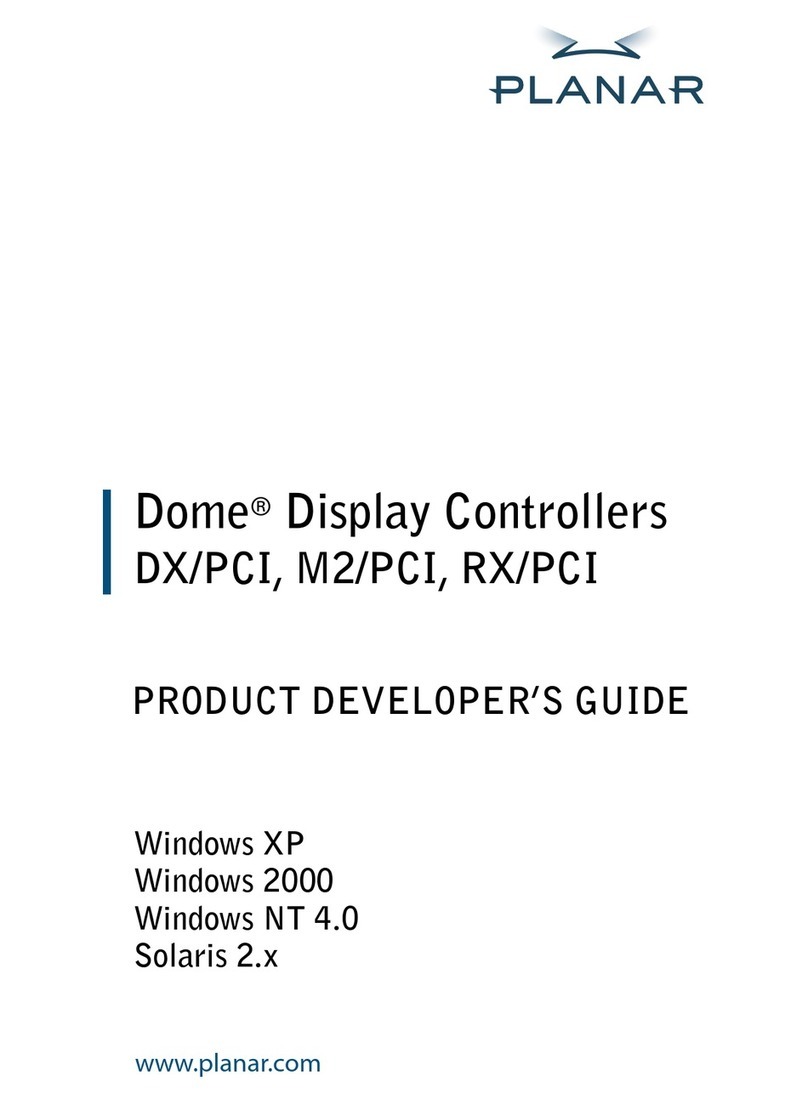
Planar
Planar DX/PCI user guide
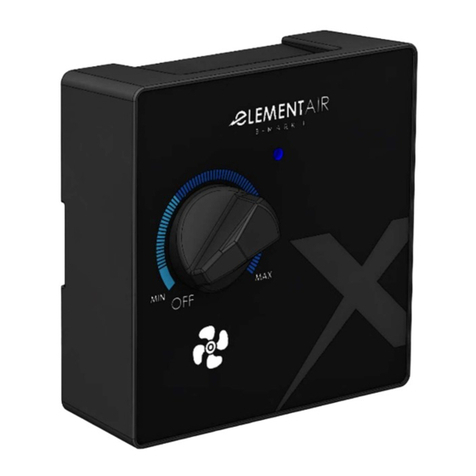
Xvent
Xvent ELEMENTAIR B-MARK I Operation and installation instructions
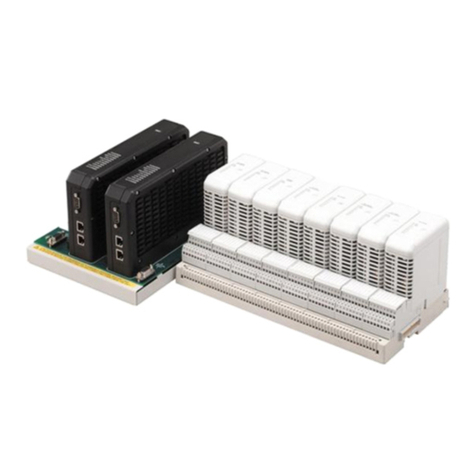
GE
GE PAC8000 series user manual


